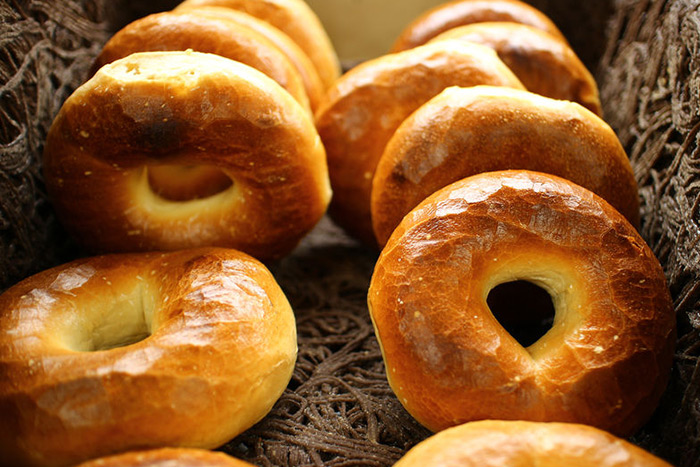What’s the Difference Between a Bagel? A Local Baker Explains

What’s the difference between a bagel? Or, to put it another way, what makes one bagel different from another? How long does it take to train a bagel baker? And why when various places use the same baking process and ingredients are the bagels so different?
In honor of National Bagel Day today, Hampton Bagels owner Bob Schepps attempts to answer these questions so frequently asked of him.
RELATED: Start Your Day with Hamptons and North Fork’s Best of the Best Bagels
Here’s what he writes:
The answer is so simple and yet so complicated. Lets start at the beginning—the bagel beginning that is. Stories have been circulating long before I started making bagels in 1978.
Polish Jews made a tribute to an equestrian prince who was successful in battle. The beugal, Austrian for stirrup, was a U-shaped bread closed at the top creating the hole. To make the dough stay in that shape during the baking process, the dough was boiled first then baked.
It worked, and the hard crust that makes a bagel a bagel was actually just an unforeseen consequence.
Right or wrong that’s the story we’ve been telling for years.
The traditional bagel is boiled, dried on boards covered with material and then flipped onto the hot shelf to bake like a pizza. The birth of the bagel goes back to how its mixed and formed into the shape we all know and love.
When you put water, flour, brown sugar, salt and yeast together you get a living growing thing. So mixing speed and duration, what temperature it reaches and how humid the bakery is all make a difference.
Almost all bagels are formed in a machine, but even these have variables and differences. I use a very old machine that presses the dough into a small cup then cuts a piece onto a belt that rolls it into a circle. Newer machines slice off chunks of dough and send it down the conveyor to form a circle.
My machine stresses the dough similar to hand rolled bagels. When the bagel comes off the conveyor belt it still needs to be tweaked by hand to get the correct shape.
Then it’s placed on wooden boards and dusted with cornmeal—so the dough doesn’t stick to the wood—and covered so it can rise.
The length of time it sits out to rise depends on seasonal temperature and humidity, and how many bagels will be put in the refrigerator. During the summer we fill it to capacity so the refrigerator has to work harder to stop the yeast from growing. We then put the dough away “younger.”
We’re ready to bake bagels the following day.
First the oven and kettle have to come up to temperature. Then it begins: We slide 100 bagels into rapidly boiling water for about a minute, then scoop them out and place them on boards covered with burlap—five on a board, 20 boards on a shelf.
The process is repeated with a second set of boards and the first set is then dry enough to be “flipped” onto the hot shelf to bake. A third batch of bagels is boiled, laid out and loaded in the oven on that set of boards. Meanwhile, the second shelf is ready to be “”flipped.”
Sounds complicated, right? That’s because it is. When you add ingredients to the bagels, like sesame or poppy seeds, it gets even more difficult.
After five shelves are loaded and set to bake, the first shelf has to be baked out and a sixth shelf is loaded. In the offseason we make an average of 15 shelves of bagels and flagels daily. It’s a lot of work.
But what makes one bagel different from another?
At every step of the process, the baker can vary the way the bagels are mixed, formed how long they proof how long they are in the kettle how long they dry on the boards and how they are flipped.
The short story is this: I give three cooks the same pots, the same stove and the same pasta and ask them each to make me a plate of spaghetti al dente. Do you think they’ll all be the same?
A bagel’s maker and baker can make all the difference in how it comes out. It takes up to a year of helping and learning to be a Master Bagel Baker.
Hampton Bagels is located at 252 W. Montauk Highway in Hampton Bays. Visit hamptonbagels.com for more info.



